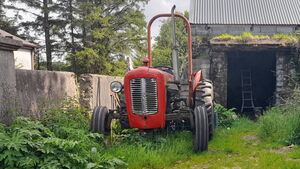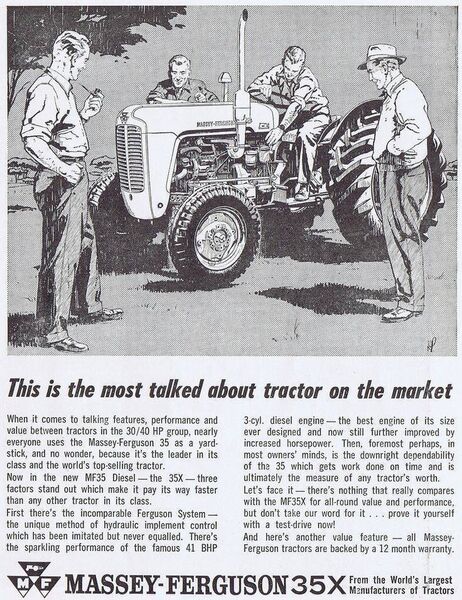The Massey Ferguson 35 – The People’s Tractor

It has been said that no other tractor has done more to feed the people of the world than the Massey Ferguson 35. Picture: Pat McCarrick
Those opening lines might seem like a Massey Ferguson advertisement from the 1950s but in fact they are from today, promoting the sales of this unique tractor to farmers in Africa. An accompanying image shows a pristine ‘35’ ploughing the red earth of Tanzania. No doubt the manufacturers used the same lines back in the 1950s as they tried to entice farmers to buy the same tractor, to plough the small fields around the Ox Mountains.
The Ferguson 35 was conceived in the United States. In 1953, a team led by Hermann Klemm started developing a new model for the Ferguson manufacturers. Klemm wrote to Harry Ferguson that year to tell him of the new design but Ferguson was unhappy with the project, and ordered Klemm to stop work. However, after another letter from Klemm, running to some 23 pages, Ferguson saw the light and the new Ferguson 35 was launched in the United States on January 5, 1955.
In the United Kingdom, the same model was launched on October 1 the following year and so we were presented with the little red tractor we know and love to this day. The new tractor was built at the Massey Ferguson factory in Coventry. The ‘35’ was a successor to the Ferguson 20, which ceased production that same year. Whilst the ‘20’ had been an all-grey tractor, earning it the nickname ‘Little Grey Fergie’, the new ‘35’ had a grey shell and wheels, and a bronze finish for the body, leading to it becoming known initially as the ‘Gold Belly’. In 1957, the colour scheme was changed to red.
In 1959 Massey Ferguson began using a new diesel Perkins engine in the MF35 and in 1962 the company launched the MF35X, which had an increased power output. This remains the more popular version for many collectors. Production ceased in 1964, when the trusty ‘35’ was in turn replaced by the Ferguson 135. By the time production of the Ferguson 35 ceased, over three million units had been built at the Coventry plant.
I have written in the past about the Ferguson 20. In its day, it too was innovative but like all great inventions, it was eventually replaced. An article in (July 2022), explains the transition from the ‘20’ to the ‘35’.
“This was one of the key tractors that brought mechanisation to many farms around the country, the advantages of which were quickly realised. Having been in production for almost 10 years, a successor was required for the ‘20’ and these were big boots to fill.” The ’35’ was like the Little Grey Fergie on steroids. It was a handsome little hunk and was so popular and so durable that countless models survive to this day in various states of rustiness, readiness and restoration.
When I was growing up, we had a ‘35’. It had the registration number SEI 899. Its engine had a sweet sound; it was as if a little wren hidden in the heart of the engine was singing harmony with Frank Perkins. This tractor replaced our Farmall Cub and compared to that little bantam, it seemed like a heavyweight.
Easy to drive yet powerful to use, the Ferguson 35 was suited to most jobs on an Ox Mountain farm in the 1970s; marsh, mountain or meadow, none of them posed a problem. Mind you, my father never got the hang of mowing with it. Deeply regretting the passing of the mid-mount mower of his beloved Farmall Cub, he could never figure out how to keep an eye on the mower behind while steering his way ahead.
The real beauty of the ‘35’ was its simplicity; a child could drive it… and often did. The controls were simple to operate and if you could reach the clutch and reverse a trailer, you were in business. An early silage contractor in our locality staffed his outfit of trusty 35s with his own children, most of them still in primary school.
These tractors were a joy to manoeuvre and could fit as neatly through the gaps on a small farm as an ass and cart. The versatile tractor drew all kinds of comments about being hard started and difficulty to repair but the reality was that they gave very little trouble at all. If one could remember to drain the radiator on frosty nights, keep them in oil and give the odd blast of EasyStart up the vent, the job was a goodun!

There came a day when it was compulsory to have a roll bar fitted to all such open-top tractors. It was necessary to prevent serious injury, or even death, in the event of such vehicles overturning. Of course it was an essential move, but for me it took from the appearance of tractors such as the Ferguson 35. It changed their shape and forced them away from their simple design. Some farmers went the whole way, skipping the roll bar, going instead for a complete weather proof cab.
This Ferguson was stout enough to plough a lea field with a two-furrow plough. In the time it would take to harness a horse, the man on a ‘35’ would have his field half ploughed. This tractor was light enough to take to the bog; with the addition of double wheels, it could float over soft banks and marshy spreading ground. Then, when the turf was saved, it could pull the full of a 10x6 trailer, seven or eight miles to a high mountain turf shed.
In addition to all this, our red friend could chop down a meadow with a finger bar mower, shake it out with a PZ and then buck-rake the saved hay to a nearby hay shed. No champion pony, no horse that ever walked in shoes, could hold a candle to a Ferguson 35.
To finish where we started, in East Africa, the Ferguson corporation promo continues to draw in the prospective buyer.
“The MF 35 puts tractor power within everyone’s reach. It brings mechanisation to a new generation of farmers, farm workers and emerging agricultural businesses. It could transform the livelihood of your family or your community.” Tractors have come a long way since the mid-1950s but it seems the simple farmers of Tanzania and Uganda are still many years behind. Today, for those who can afford it in the Developing World, a new MF35 will set them back the equivalent of €4,000. Funnily enough, a restored ‘35’ here at home, could cost up to twice that amount.
It has been said that no other tractor has done more to feed the people of the world than the Massey Ferguson 35. Nice to see that its work still continues to this day.





